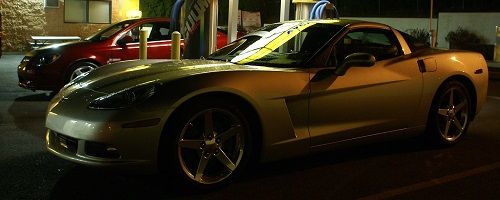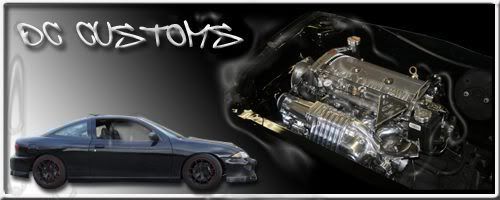Leafy (Club Jeffie FEA man) wrote:No the 5.3 is bigger than the northstar and even the northstar required basically an entirely new frame from the fire wall forward. FWD sucks, honestly putting an engine that big in a fwd car is just retarded. It'll handle like asshole in a cup and wont be able to put any power down.
The Northstar is physically a larger and heavier of an engine than the 5.3L LS4. On the LS4, it is uses a OHV while the Northstar is DOHC, in other words, the NS uses two huge/wide/ top heavier banks.
The "Small Block" are realitvely small in size for being a V8. This LS4 is under that same architecture, just designed for FWD use.
Personally, if I was swaping motors with more cylinders... I'd take the LS4 than those boat anchors OHV V6s--ie... 3.1/3.4L.
Here is what GM said on it.
NEW GEN IV 5.3L TURNS V-8 PERFORMANCE ON ITS SIDE
General Motors’ new Gen IV 5.3L V-8 (LS4) engine debuts in the 2005 Pontiac Grand Prix GXP, making it the first V-8 offered in a Grand Prix since 1987. It also marks the first time since the small-block was introduced 50 years ago that it has been offered in a front-wheel-drive car.
Engineered specifically for front-drive layouts, the 5.3L V-8 is estimated to produce 303 horsepower and 323 lb.-ft. of torque. It incorporates Displacement On Demand technology (DOD), which helps the vehicle realize fuel economy gains of up to 12 percent per the EPA federal fuel economy test procedures. It does this by seamlessly alternating between eight- and four-cylinder operation.
When matched with the inherent smoothness and torque of the V-8 configuration, the 5.3L V-8 delivers strong performance – 90 percent of torque is available between 1500 rpm and 5200 rpm – and surprising economy. It’s a combination most competitors’ V-6 offerings can’t match.
“Over 50 years, the small-block V-8 has proven itself more adaptable than anyone could have imagined,” said Dave Muscaro, assistant chief engineer of small-block V-8 for passenger cars. “The small-block family has a tradition dating back to 1955 in which an excellent design makes possible the additions of new technology. The Displacement On Demand capable 5.3L V-8 is a fine example of that tradition”
Family ties
The all-aluminum 5.3L V-8 is the third displacement offering of the Gen IV small-block, which was introduced in the 2005 Chevrolet SSR, GTO and Corvette, as well as several 2005 GM SUVs. The 5.3L V-8 shares a common architecture with these other versions, including a deep-skirt block, six-bolt cross-bolted main bearing caps, and structural oil pan, but is modified to accommodate the “east-west” mounting position of the Grand Prix’s front-wheel-drive chassis.
To fit the “sideways” positioning in the Grand Prix, several changes were made to shorten the engine’s overall length. The crankshaft was shortened by 13 mm – 3 mm at the rear and 10 mm at the front – and the entire accessory drive system was designed to reduce space. The water pump and all other accessories, including the power steering pump, are driven on a single-belt drive system – the longest drive system in a GM vehicle.
Engineers devised an elongated water pump manifold, which features a remote-mounted pump that feeds the stock Gen IV coolant passages via the unique manifold. The design allowed the drive system to be mounted closer to the engine block. Because of the 5.3L V-8’s relatively low inertia, which can be up to 50 percent less at the crankshaft damper than a 6.0L V-8, a hydraulic belt tensioner was used instead of a conventional rotary tensioner.
Unique position
The sideways position of the 5.3L V-8 required revisions to the lubrication system. Engineers tested 5.3L V-8 equipped test vehicles on racetracks, subjecting them to high-load turns that guided the development of special oil pan baffles that ensure lubrication during cornering. In addition, because Gen IV engines don’t have a block-mounted oil filter – it’s located on the oil pan – the 5.3L V-8’s filter offers easy access.
The GM Oil Life System oil-change indicator system is standard, which can reduce the frequency of oil changes during the engine’s operating life. With the system, the engine control module (ECM) records cumulative data on a number of variables, including engine rpm, temperature, load or rpm variance and length of operation at any given load and temperature. Using this information, the system calculates oil degradation and recommends an oil change when the oil is near the end of its useful life – in other words, when an oil change is actually needed.
Other 5.3L V-8 features include:
•Electronic throttle control integrated with a new E40 engine controller
•Lightweight, three-piece friction-welded composite intake manifold with throttle located at rear (driver’s side) of engine
•Cylinder heads derived from the 6.0L V-8 LS2 engine
•10.0:1 compression ratio
•Unique camshaft designed to accommodate DOD technology
•PCV valve replaced with maintenance-free fixed orifice
Because of the front-drive layout, the 5.3L V-8’s exhaust manifold routing includes two manifolds joined by a single crossover pipe, which connect to a single underbody catalytic converter. The crossover pipe allows the use of a single oxygen sensor, unlike north/south V-8 applications that have two oxygen sensors.
Displacement On Demand technology
GM’s Displacement on Demand technology debuted in 2005 GM extended midsize SUVs equipped with the Vortec 5.3L V-8 (LH6) engine. With the 5.3L V-8 (LS4), DOD technology enables fuel economy gains of up to 12 percent in certain driving conditions by reducing the number of cylinders engaged in the combustion process. A sophisticated, next-generation E40 engine controller determines when to deactivate cylinders, allowing the engine to maintain vehicle speed in lighter-load conditions such as highway cruising. When the cylinders are deactivated, the engine effectively operates as a V-4, with alternate cylinders on each cylinder bank disabled. The engine returns to V-8 mode the instant the controller determines the vehicle speed or load requires additional power. The process is seamless and virtually imperceptible.
“There’s nothing like the satisfying feel of a V-8 engine and the 5.3L V-8 provides a level of performance rarely available in competitors’ vehicles,” said Muscaro. “But when all eight cylinders aren’t required to maintain performance, DOD technology effectively turns the engine into a more efficient V-4.”
The key to DOD’s efficiency and virtually imperceptible operation is a set of special two-stage hydraulic valve lifters, which allows the lifters of deactivated cylinders to operate without actuating the valves. These lifters, used only on the cylinders which are deactivated, have inner and outer bodies which normally operate as a single unit. When the engine controller determines cylinder deactivation conditions are optimal, it activates solenoids in the engine lifter valley which direct high-pressure oil to the switching lifters. This oil pressure activates a release pin inside the lifter which allows the outer body of the lifter to move independently of the inner body. With the pin is released, the outer lifter body moves in conjunction with camshaft actuation, but the inner body does not move, thus holding the pushrod in place. This prevents the pushrod from actuating the valve, thereby halting the combustion process. Because the vibration and acoustic dynamics of the V-8 and V-4 modes are different, the exhaust system of DOD-equipped vehicles is tuned to compensate for the changes.
>>>For Sale? Clicky!<<<
-----The orginal Mr.Goodwrench on the JBO since 11/99-----










